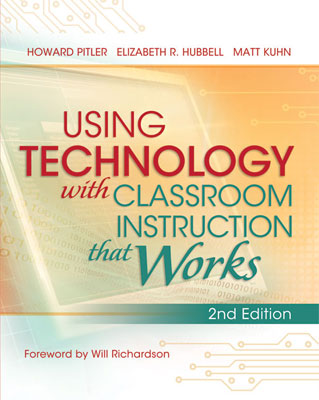“Our students must learn not only how to use current technologies, but also how to evaluate which ones work best for particular tasks or projects,” write Howard Pitler, Elizabeth R. Hubbell, and Matt Kuhn in their latest edition of Using Technology with Classroom Instruction That Works, 2nd Edition. In the digital age, that is the crux of our instructional problem: how do we give students the experiences with digital technologies that make them effective consumer-users? And, how do we do this without being technologically-tool centered, when the tools so rapidly change? Pitler, Hubbell, and Kuhn offer one effective approach: focus on the instructional methods that work, and then engage students in using technology while employing those research-based instructional strategies. Using the high-yield instructional strategies found in the book
Classroom Instruction That Works, the authors show how technology might be employed in the service of using each of these instructional strategies:
- Setting Objectives and Providing Feedback
- Reinforcing Effort and Providing Recognition
- Cooperative Learning
- Cues, Questions, and Advance Organizers
- Nonlinguistic Representations
- Summarizing and Note Taking
- Assigning Homework and Providing Practice
- Identifying Similarities and Differences
- Generating and Testing Hypotheses
Using Technology with Classroom Instruction That Works takes readers through each of these high-yield instructional strategies and then points out specific kinds of technologies that lend themselves to helping teachers engage in those teaching strategies. For example, Identifying Similarities and Differences is a strategy that research says brings the highest levels of gains in student achievement. Pitler, Hubbell, and Kuhn’s book gives educators ideas on how to engage students in the use of this instructional strategy through the use of different categories of technological tools. At the same time, the authors offer readers many examples of how practicing teachers are using those technologies in the manner they describe. The categories of technologies these authors focus on include:
- Word Processing Applications
- Organizing and Brainstorming Software
- Data Collection and Analysis Tools
- Communication and Collaboration Software
- Instructional Media (Learner as Consumer)
- Multimedia Creation (Learner as Producer)
- Instructional Interactives
- Database and Reference Resources
- Kinesthetic Technology
Using Technology with Classroom Instruction That Works is not a "how-to" book when it comes to employing technology in the engagement of instruction. Rather, it is a "big-picture" book that surveys the field of technological tools and helps the teacher connect with the kinds of technology she might wish to use in the classroom.
Educators in the classroom up to district leaders, who are interested in what kinds of tools teachers and students can use with research-based instruction, will find this book quite useful.


J,
ReplyDeleteThank you for this wonderful write-up and description of the book. You're right - this is less of a "how-to" (even less so than the 1st edition), but hopefully something that helps teachers focus on the purposes of the tools they have available.
Thank you again!
Elizabeth